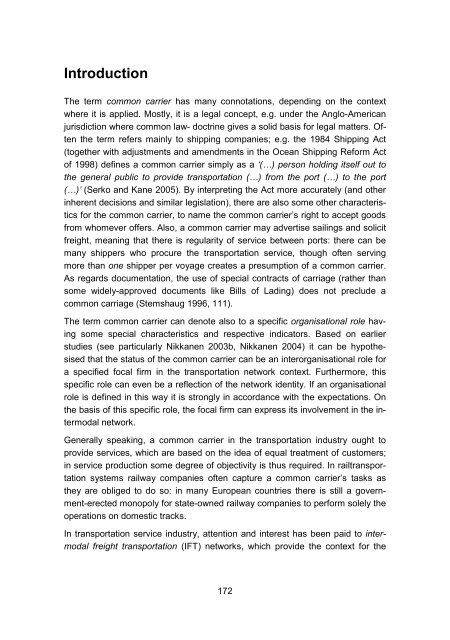849954 sisus
849954 sisus
849954 sisus
Create successful ePaper yourself
Turn your PDF publications into a flip-book with our unique Google optimized e-Paper software.
Introduction<br />
The term common carrier has many connotations, depending on the context<br />
where it is applied. Mostly, it is a legal concept, e.g. under the Anglo-American<br />
jurisdiction where common law- doctrine gives a solid basis for legal matters. Often<br />
the term refers mainly to shipping companies; e.g. the 1984 Shipping Act<br />
(together with adjustments and amendments in the Ocean Shipping Reform Act<br />
of 1998) defines a common carrier simply as a ‘(…) person holding itself out to<br />
the general public to provide transportation (…) from the port (…) to the port<br />
(…)’ (Serko and Kane 2005). By interpreting the Act more accurately (and other<br />
inherent decisions and similar legislation), there are also some other characteristics<br />
for the common carrier, to name the common carrier’s right to accept goods<br />
from whomever offers. Also, a common carrier may advertise sailings and solicit<br />
freight, meaning that there is regularity of service between ports: there can be<br />
many shippers who procure the transportation service, though often serving<br />
more than one shipper per voyage creates a presumption of a common carrier.<br />
As regards documentation, the use of special contracts of carriage (rather than<br />
some widely-approved documents like Bills of Lading) does not preclude a<br />
common carriage (Stemshaug 1996, 111).<br />
The term common carrier can denote also to a specific organisational role having<br />
some special characteristics and respective indicators. Based on earlier<br />
studies (see particularly Nikkanen 2003b, Nikkanen 2004) it can be hypothesised<br />
that the status of the common carrier can be an interorganisational role for<br />
a specified focal firm in the transportation network context. Furthermore, this<br />
specific role can even be a reflection of the network identity. If an organisational<br />
role is defined in this way it is strongly in accordance with the expectations. On<br />
the basis of this specific role, the focal firm can express its involvement in the intermodal<br />
network.<br />
Generally speaking, a common carrier in the transportation industry ought to<br />
provide services, which are based on the idea of equal treatment of customers;<br />
in service production some degree of objectivity is thus required. In railtransportation<br />
systems railway companies often capture a common carrier’s tasks as<br />
they are obliged to do so: in many European countries there is still a government-erected<br />
monopoly for state-owned railway companies to perform solely the<br />
operations on domestic tracks.<br />
In transportation service industry, attention and interest has been paid to intermodal<br />
freight transportation (IFT) networks, which provide the context for the<br />
172








